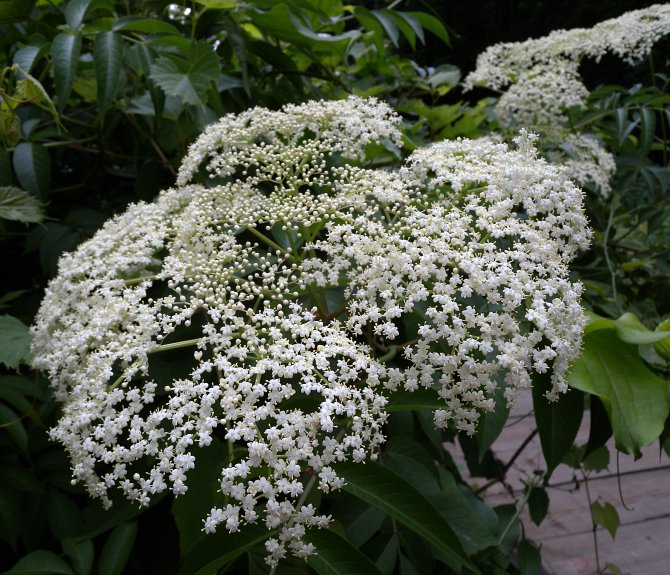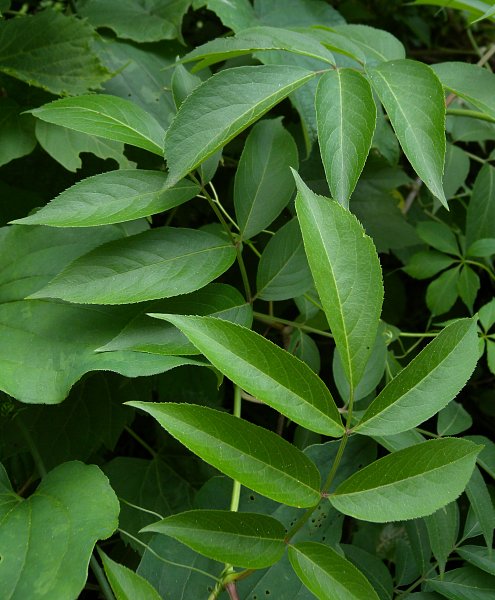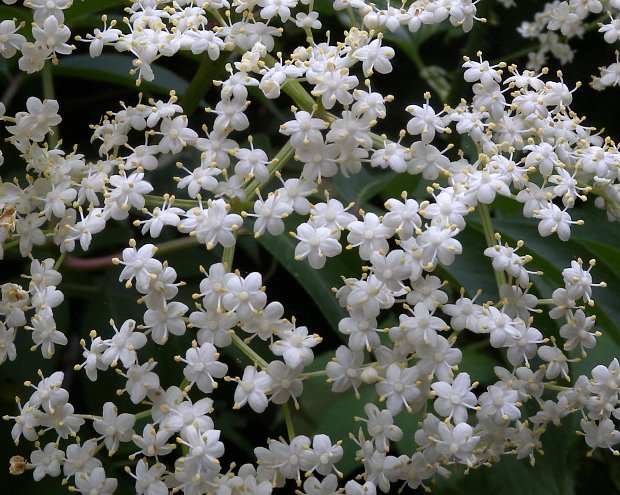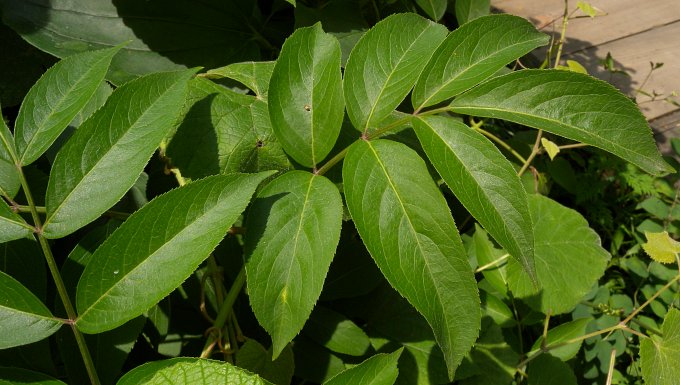Description: This is a deciduous shrub about 4-12' tall. It is usually a multistemmed shrub; these woody stems usually have an arching habit, creating a relatively loose broad crown. On larger and older woody stems, the bark is light grayish brown and warty in appearance from scattered short lenticels (air pores). Young woody branches are light grayish brown or light yellowish brown and more smooth, although scattered short lenticels are still evident. Young shoots are light green. The pith of young branches and stems is relatively large in cross-section and white; they are somewhat brittle and weak. Along these young branches and shoots, there are pairs of opposite compound leaves; they are about 6-12" long and a little less across. These compound leaves are mostly simple-pinnate with 5-9 leaflets (2-4 pairs of opposite leaflets and one terminal leaflet). Sometimes the innermost pair of leaflets on a compound leaf are divided into 3 subleaflets that are slightly smaller in size than the simple leaflets. The leaflets are 2½–5" long and ¾–2" across; they are lanceolate or elliptic in shape and serrated along their margins. The upper leaflet surface is medium to dark green and glabrous, while the lower leaflet surface is light green and either glabrous, slightly hairy along the major veins, or short-pubescent throughout. The petioles (basal stalks) and rachises (central stalks) of the compound leaves are light green to purplish green, narrowly grooved above, and convex below. Crushed foliage and shoots have an unpleasant aroma with astringent qualities.

The upper stems terminate in umbel-like panicles of flowers that span 3-10" across. Immature panicles are flattened above, but later these panicles become more dome-shaped. The intricate branches of the panicle are narrowly grooved along their upper surfaces and convexly shaped below; they are initially light green, but later become bright reddish purple when the drupes become mature. Each flower spans about 4-6 mm. (up to ¼") across, consisting of a short cup-shaped calyx that is light green and barely toothed, a white corolla with 5 spreading lobes, 5 exserted stamens, and an ovary with 3 early-deciduous short styles. The blooming period occurs from late spring to mid-summer, lasting about 3-4 weeks. The flowers have a rather strong fragrance that is sweet, but with musty overtones; they are capable of self-fertilization. Afterwards, the flowers are replaced by drupe-like fruits. At maturity during mid- to late summer, these drupes are about 4-5 mm. (a little less than ¼") across, dark purple to black, glabrous, and globoid in shape. Each mature drupe has a juicy interior with 3-5 small seeds. The flavor of these drupes is sweet, although with a slightly bitter aftertaste. The root system is shallow and rhizomatous. Clonal offsets often develop from the spreading rhizomes.

Cultivation: The preference is full to partial sun, moist conditions, and a fertile loamy soil. This is a fast-growing shrub, but it is usually short-lived. Nonetheless, it is able to maintain its presence in a given locale for longer periods of time through the formation of clonal offsets. Such offsets can be controlled by regular mowing. Once this shrub becomes established, it is easy to maintain and mostly problem-free.
Range & Habitat: The native Common Elderberry (Sambucus nigra canadensis) is quite common, occurring in every county of Illinois (see Distribution Map). It is widely distributed in the eastern half of the United States and adjacent parts of southern Canada. Habitats include river-bottom prairies, moist meadows in woodlands, disturbed open woodlands, woodland borders, thickets, gravelly seeps, banks of streams and ditches, powerline clearances in wooded areas, fence rows, shrubby areas along railroads, and abandoned fields. Common Elderberry is a pioneer species that is often found in habitats with a history of disturbance. It is one of the shrubby invaders of moist prairies in Illinois.

Faunal Associations: The flowers provide only pollen as a floral reward to insect visitors. This attracts occasional bees, flies, and beetles, more specificially: honeybees, small carpenter bees (Ceratina spp.), Halictid bees (Lasioglossum spp., Halictus spp.), Syrphid flies, bee flies (Bombyliidae), Muscid flies, other miscellaneous flies, long-horned beetles (Cerambycidae), tumbling flower beetles (Mordellidae), scarab beetles, and other miscellaneous beetles (Robertson, 1929; Lovell, 1898; Williams, 2006; Gosling, 1986; Lovell, 1915; Lisberg & Young, 2003). Small carpenter bees also tunnel into the soft pith of this shrub to construct their nests, causing little damage (Cranshaw, 2004). Other insects feed destructively on the foliage, roots, buds, and other parts of Common Elderberry (Sambucus nigra canadensis). This latter group of insects includes such species as larvae of a long-horned beetle, the Elder Borer (Desmocerus palliatus), larvae of several gall flies (Cecidomyiidae), several polyphagous stink bugs, the Elder Aphid (Aphis sambuci), larvae of several sawflies (Tenthredinidae), larvae of the Elder Shoot Borer Moth (Achatodes zeae), and thrips (Neohydatothrips sambuci). The Insect Table has a more complete list of these insect feeders. Among vertebrate animals, the fruits of Common Elderberry are a popular food source for many species of birds, including the Cedar Waxwing, Northern Cardinal, Blue Jay, Song Sparrow, Common Grackle, Gray Catbird, Yellow-breasted Chat, Wild Turkey, Greater Prairie Chicken, Yellow-bellied Sapsucker, European Starling, Grey-cheeked Thrush, Eastern Bluebird, American Robin, and Alder Flycatcher. The Bird Table has a more complete list of these bird species. Some birds also use this shrub for protective cover and nesting sites. Because the foliage of Common Elderberry is toxic and bitter-tasting, it is used less often as a food source by mammals. However, the Domesticated Goat has been observed to feed on this shrub and the Cottontail Rabbit sometimes gnaws on the bark during winter, while the Fox Squirrel and American Black Bear sometimes feed on the fruit (Blackmore, 1998; Mosnier et al., 2008; Martin et al., 1951/1961). In addition, two species of turtles, the Eastern Box Turtle (Terrapene carolina) and Eastern Mud Turtle (Kinosternum subrubrum), have been observed to feed on the fruits (Ernst et al., 1994) of elder shrubs (Sambucus spp.).

Photographic Location: The photographs were taken along a boardwalk at Busey Woods in Urbana, Illinois.
Comments: Common Elderberry (Sambucus nigra canadensis) is an attractive native shrub with fragrant white flowers and dark purple to black drupes. Because it is rather ubiquitous, this shrub is often taken for granted, even destroyed without much thought, notwithstanding its outstanding value to fruit-eating birds. The small fruits of this shrub are edible when they are fully ripe and cooked, and they can be eaten raw in small amounts without harm. These fruits have been used to make elderberry jelly, pie, and wine, although this was done more often in the past than in the present. The only other native elderberry shrub in Illinois, Red Elderberry (Sambucus racemosa), has bright red fruits that are regarded as inedible. This latter shrub has been found in northern Illinois, where it is uncommon. At the present time, Common Elderberry is widely regarded as a subspecies of a similar European shrub, Black Elderberry (Sambucus nigra nigra). In the past, Common Elderberry was considered a distinct species and referred to as Sambucus canadensis.